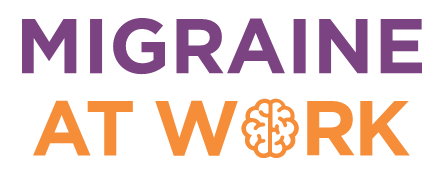Bringing Brain Care to the Front of Migraine
Have you ever been in a meeting when it was shared that a coworker was out for the day due to a migraine? Let’s call her Lucy. Claudia makes a remark about it just being a headache and infers that Lucy probably just didn’t have her work done or wanted the day off. Jeronimo rolls his eyes and asks when she will return. And next thing you know Kelly is dialing up Lucy for a status update on her part of the project. Lucy didn’t answer the phone. The team calls Lucy again because it is just a headache. Again, Lucy does not answer. Bill opens up his laptop and fires Lucy off an abrupt email related to when she will return to the office and complete her work. The tension in the room rises and Lucy is none the wiser.
Now this is a fictional scenario that has been pieced together from unfortunate situations I have witnessed and been a part of in the workplace. I have been Lucy and my colleagues have called, emailed, texted and so on for a laundry list of “reasons” that I’ve been given over the years when I’ve not been at work due to migraine. With more than 90% of those with migraine being unable to work or function normally during their migraine 1 , it is time to bring brain care to the forefront of the migraine conversation across all settings- including the workplace.
What is Brain Capital?
The Organization for Economic Co-operation and Development (OECD) recently introduced the concept of a brain capital in a growing brain economy. Sandra Bond Chapman, PhD, defines brain capital as the “economic benefit that accrues from keeping our brains powered at the highest level.” 2 Many jobs require cognitively demanding tasks, along with emotional and social skills, where innovation is a desirable “deliverable” of employee productivity. These brain-based skills and functions are driving our job market and shaping our workplaces.
There is a global need for the investment in brain health and brain skills to support the post-COVID world for economic growth. The workplace setting during the current pandemic, coupled with the shifting workplace demands, is ripe to benefit from an investment in brain health and wellness for all in the organization, including individuals with migraine disease.
Understanding Brain Health
Unfortunately, there is not a universal definition of brain health that is commonly recognized across the world, or even in the United States. Broadly, brain health is conceptualized in various pillars of wellness such as the well-known “mind, body, spirit” model with associated tasks such as “thinking, moving, feeling.” The World Health Organization states that, “Good brain health is a state in which every individual can realize their own abilities and optimize their cognitive, emotional, psychological and behavioral functioning to cope with life situations.” 3
Migraine and Brain Health
Research suggests that brain health is 90% lifestyle and 10% genetics. 4 Furthermore, prioritizing brain health is for everyone, regardless of a brain related condition, health diagnosis, or other factors. This notion extends to individuals living with migraine disease and related headache disorders. Brain health examines lifestyle factors which impact our overall well-being across our lifetime taking into consideration that our brains are constantly changing for a variety of reasons.
The SEEDS model– stress, eating, exercise, drinking, and sleep- highlights some of the top ranked health concerns for brain health. 5
Stress: Relax the mind and avoid daily stressors.
Eating: Eat to fuel the mind and body.
Exercise: Engage in an ongoing exercise routine for the brain and body. Aim for 150 minutes of moderately intense exercise per week and aim for 20 minutes of cognitively stimulating exercise per day with a task that is new, novel, and challenging. 6
Drinking: Limit alcohol consumption and keep properly hydrated with water, an essential element to the brain’s ability to function properly.
Sleep: Aim for 7-9 hours of sleep per night and plan brain breaks (see examples below!) throughout the day to help unwind.
Following SEEDS for brain health and migraine management emphasizes the ability individuals have to play an active role in their personal brain care. For many people living with migraine disease, the above research-informed lifestyle factors may already be top of mind. (Please note that this list is not extensive and there are more factors that can impact our brain health.)
Currently, the available research related to brain health and migraine is limited, but is luckily a growing area of interest. Individuals with migraine disease do not have poorer related brain health 7 , but we may tend to speak more commonly and openly with our healthcare providers about brain health related issues such as brain fog, depression, anxiety, and memory concerns. Ultimately, just like in otherwise healthy populations, the brain health of those with migraine and other headache disorders are largely individualized.
Navigating the Workplace with Migraine
Finding ways to navigate migraine at work is not always an easy path. It is estimated that of those individuals in the workforce, 14-19% of them live with migraine disease. 8 In one survey of over 11,266 individuals across 31 countries, all with more than 4 migraine attacks per month, 88% of the respondents reported migraines had a negative impact on their working life. 9
Many people working with migraine are unlikely to disclose their diagnosis to their employers. Many employees with migraine are afraid of discrimination or judgement and avoid disclosing to their employer. This leads to migraine hiding in plain sight, and employers being unaware that migraine is such a burdensome issue in their office.
Even when employees do feel either comfortable or desperate enough to disclose, many employers will not know how to help. One study collected data from those both frequently and severely affected by migraine. Participants needed to have frequent attacks and also find preventive medications ineffective. 90% of this group disclosed their diagnosis with their employers, and less than half of those employers offered support to those employees. 10 Keep in mind that this percentage of those sharing with their employers is likely dramatically higher than in an average workplace.
Modifying the Office to be Migraine-Friendly is to Make it Brain-Friendly for All Employees
A call to protect the brain health of all employees, including individuals with migraine disease, while producing brain skills for the organization will offer dual benefits. Many workplaces are full of migraine triggers. 11 While individuals with migraine disease may seek accommodations in the workplace related to light, sound, and smells for their personal wellness, many slight modifications could offer benefits that would extend to others to build better brains.
Light: Both the brightness and color of light surrounding us affects our moods. 12 The ability to adjust our light for our personal workspace preference can lead to a boost in productivity, uplift in spirit, and a variety of health-related effects. 13
Sound: Our brains’ ability to filter out background noises in the workplace while attending to work-related tasks can be tiring. 14 Excessive noise has been linked to a decrease in productivity and concentration, stress, fatigue, difficulty in communication, and health related issues depending on the work environment and noise exposure. 15
Smell: Our sense of smell is strongly linked to our memory. Aroma is linked to our cognitive performance known as our brain-based skills in the workplace. 16 Odors both good and bad can impact our mood, behavior, and performance at work. 17
Touch: Ergonomic office settings can help boost productivity and employee satisfaction. 18 As every individual is unique, find what works for you. Whether it is an ergonomic keyboard or a standing desk, there are many options to improve productivity and your own physical comfort.
There are many simple ways to support some of the main workplace concerns for individuals with migraine disease that can also benefit the entire workplace such as: implementing fragrance-free policies, establishing policies to minimize odors in meal areas and trash, providing desk lamps or lighting alternatives, and other modifications can help. Many brains can benefit from options purposefully designed to set them up for success. Investing in brain capital for employees makes economic sense as we align our workplace wellness values.
Brain Wellness, Migraine, and the Workplace
No two brains are alike, just like individuals’ lived migraine experiences are not alike. We have the unique ability to impact our brain and at times we can utilize our surroundings to thrive at work while minimizing environmental triggers. Employers looking to invest in the brain health and wellness of their employees, with or without migraine disease or a related headache disorder, will bode well in the future of our brain capital economy.
Conclusions
- Now is the time for brain health in the workplace for all- both communal gathering spaces and remote settings.
- Prioritizing brain wellness in the workplace offers benefits for both employees and employers for minimal or no cost.
- Many individuals living with migraine disease have likely been making choices to optimize a brain-healthy lifestyle already.
Three Brain Health Tips for All
- Brain care is self-care. Make your brain-care a priority and not an option. Start simple. Purposefully make one decision each day that is better for your body and brain. Small changes can lead to lasting habits. We have the ability to build daily habits and plans that nourish our minds, bodies, and spirits during tough times and we can try new things to support our brain-care needs as they ebb and flow.
- Take 5-minute brain breaks. Build-in brain breaks throughout your day to optimize your brain performance and prevent fatigue and low mood. A brain break should be purposeful engagement in a brief, meaningful exercise or activity and a “break” from other tasks that require concentration and focus.
Get up and move, do some light stretching, spend time with your pet, get outdoors, write in a gratitude journal, experience a good laugh, or read a poem aloud. Take multiple brain breaks daily and use these as a tool to prevent tiredness, frustration, lack of focus, or feelings of low mood. - Ready to get brain-healthy at work? Start with this guide today!




